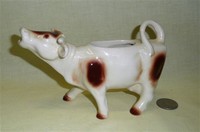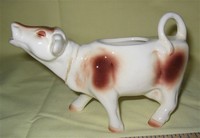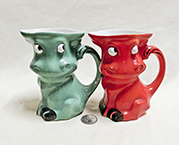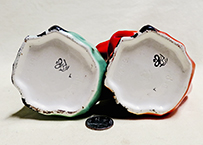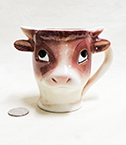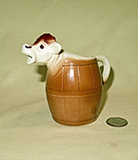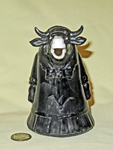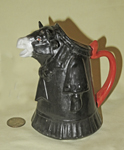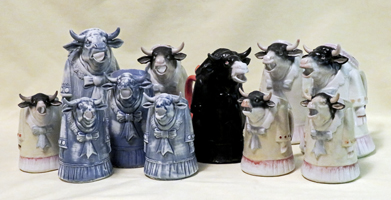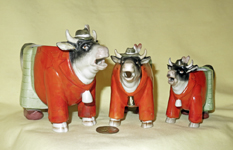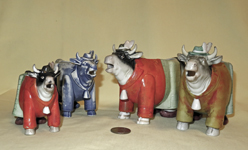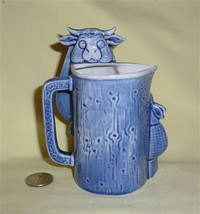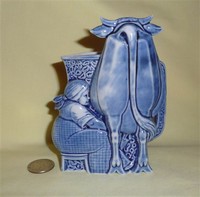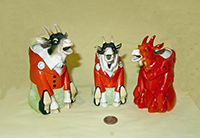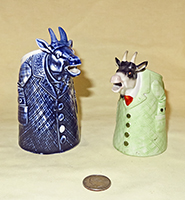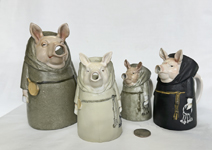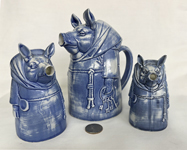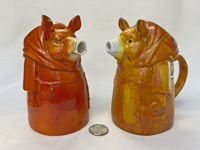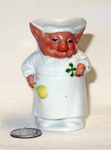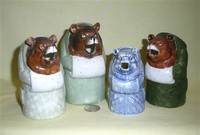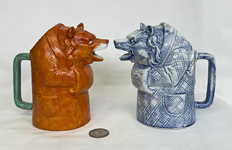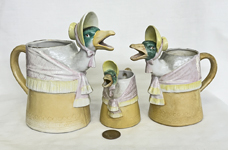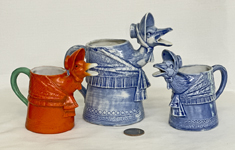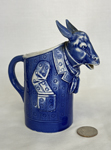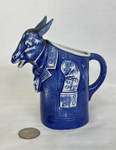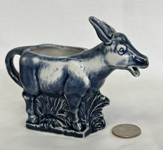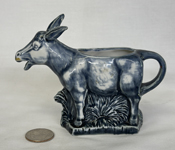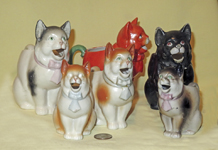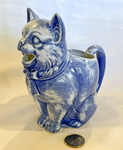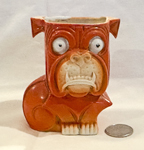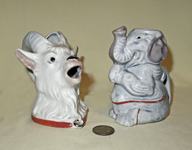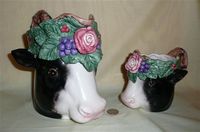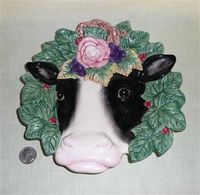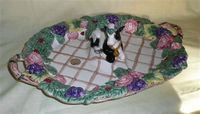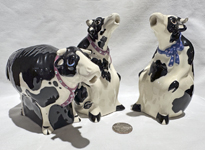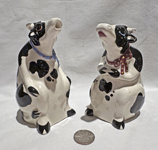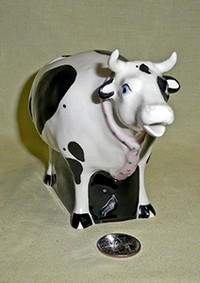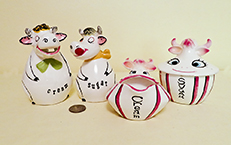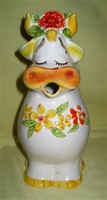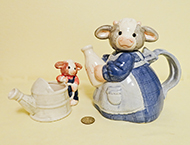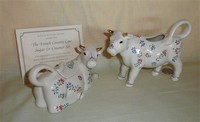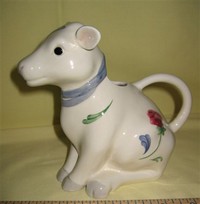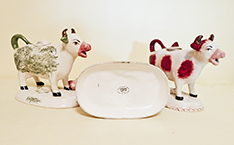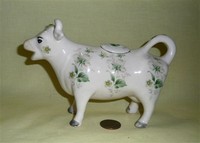
Favorite Brands
Many ‘modern’ creamers (and teapots, and pitchers, etc) have stickers or marks which identify their makers, and I’ve tried to identify them in the appropriate theme section. Here I’m featuring just a few factories or brands, selected either because I have quite a number of their cows in my collection, or because their brand names are quite well known, or just because I personally find them pretty special.
There are two makers or cow creamers that I like best of all. The first of these is Goebel of (West) Germany, perhaps best known for their Hummel figurines (yes, I had some Hummels --inherited from my Grandmother and since passed to one of my sons -- but they don’t pass muster for this collection). Goebel seems to have made quite a number of cow creamers and pitchers over the years (they bear a number of different Goebel marks, from the Crown through various bees), some realistic, others fanciful. I would hope that some serious Goebel collector can perhaps tell me how many cow creamers and pitchers they have actually produced – I’ve tried the web and a number of books, but without success. I will start this page with their cow creamers.
The second of my favorite makers is (or are) Schafer and Vater (S&V) of Rudolstadt, Germany. Their cow (and other animal) creamers follow the Goebels. There's a bit more about them at the start of that section.
|
|
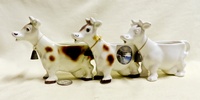 |
These Goebel caricatures of a cow with a large back opening and outsized udder (must be uncomfortable) are also fairly common, and were popular as a souvenir…at least at Niagara Falls. They all bear the Large V bee, used by Goebel from 1950-1955. The two with brown spots also say “Germany” which implies they were made for sale in the US, which requires country of origin markings. The matte white one has the Goebel mark on a hoof along with “Foreign”. That term was initially used for German products sold in the UK after WWI, but this one is too modern for that so I don’t know the reason for the designation. Maybe again UK though, since there was unlikely to be much love for German products there for quite some time after WWII. |
|
|
|
|
This one isn't quite as wild as the orange and green ones, but is still somewhat unusual in being just a cow head pitcher, presumably designed for a child. It is called "Daiseybelle" - originally it came wiuth a silver sticker with its nanme. I have also shown it on the Heads page, near a very similar one that bears a little rhyme. |
|
This is another fanciful Goebel creamer, a cow's head sticking out of a barrel. They must have been especially proud of it because in addition to the usual mark, in this case a small V=bee, if also is stamped for "Western Germany, by W. Goebel" and has an impressed mold mark of S202 as well as the date, "1960". |
|
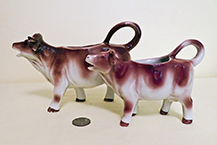 |
These two realistic early Goebel cow creamers appear very similar and bears the Crown mark. The larger has the initials “Z.V.”, and the smaller one has a mold mark that I believe to be “473”. |
 |
This one looks similar and bears the incised Crown mark as well as the letter “S” and the mold mark “465” over “3”. |
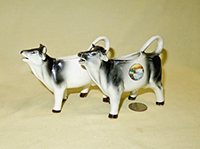 |
These two are from a very similar if not identical mold to the brown one above, and have a mold mark of 465 over 0. However they bear the large V-bee instead of the crown, in both a stamp and an impression. One of these made its way to Niagara Falls, and is also shown with other Goebel creamers from there on the Advertising and Souvenirs page. |
 |
Three more with the crown mark, displaying the differences in size and coloration of this style mold. |
|
|
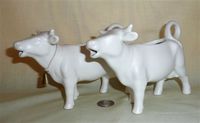 |
These two matte white Goebel cow creamers both have the stamped full V-bee mark. The one with the bell has the mark on the bottom of the left front hoof, which is unusual since brand marks are usually on the belly as is the case with the one without a bell (and less distinct mold impressions). It also has a circle with “Foreign” inside, making me think it may have been a British import. |
 |
Here is another white "Goebel, W. Germany" creamer, from a slightly different mold, and glazed. |
|
|
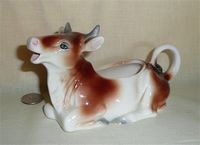 |
Finally for the Goebel part of the collection, here’s a beautifully crafted kneeling cow creamer bearing what’s known as the double crown mark: an incised “wide crown WG” which was in use from 1935-1945, also “S” and “471/2”, plus a green stamp with the same wide crown WG mark. |
|
Schafer and Vater (S&V) is my other favorite brand. Gustav Schafer and Gunther Vater founded their factory in Volkstedt Rudolstadt, Thuringa, Germany in 1890, to produce high quality porcelain. In 1896 they purchased the List Porcelain Factory at Neuhaus, and by 1910 Sears Roebuck Company began to import and distribute Schafer & Vater pottery into the US. In 1913 Paul Schafer took over from his father and, working alongside Gunther Vater, built up a successful workforce of around 200 people, using 3 kilns. In 1918 the factory was destroyed by fire and they set up a new factory to resume production. I have been told by a knowledgeable S&V collector that after this time they made only utilitarian items, so presumably all my fanciful animal creamers came from the first factory, and likely were made prior to WWI. The firm closed in 1962, and it’s believed that the East German government assumed control of the vacant factory in 1972, and all records and molds were destroyed. Schafer & Vater are well-known for comical and figural items, as well as jugs, creamers, miniature liquor bottles for distribution by pubs, special advertising runs for clients, figurines, match strikers, hair holders, “naughties”, hat pin holders, and planters. Their impressed mark is a crown above an 'R' in a star, although it wasn’t always used and frequently is indistinct. A characteristic of their pottery is the fine texture of the locally mined clay that was rich in kaolin and yielded pottery with velvety texture and very fine grain. There are a number of S&V collectors featured on the web. I have stayed strictly with their dressed-up animal creamers, but I like their work so much that I have succumbed to a number of their other animals in addition to cows, as you will see. |
|
 |
This standing lady in the yellow and pink dress is perhaps the most commonly available S&V cow creamer. S&V often made their products in multiple sizes and colors, and from what I have seen they frequently produced light blue(and bright orange and red) as well as multi-colored versions of their creamers (I have only seen the cows in multi-color and blue, but I believe there is at least a red one). |
|
|
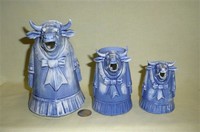 |
These three lovely well dressed blue lady cows are a good example of S&V’s size variations. The largest is 6¼” tall, the middle one 4½”, and the small one 3¾”. And who knows – there may yet be more lurking out there waiting to join my herd. |
|
|
| > | |
|
|
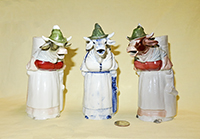 |
These creamers (at least the two on the right), although unmarked, are almost assuredly S&V by virtue of style, material, and detail such as on the skirt. Also I found one on eBay that was offered from an estate of someone who collected only S&V, and there is a blue as well as colored version. They do have illegible numbers around the base.The one on the left is a heavier ceramic, not porcelain, and lacks the fine features of the other two. A very knowledgeable S&V expert, Cody (Al McQueen) was kind enough to suggest that it is probably from the same area (Rudolstadt) since many factories made similar items and artists moved around. He also noted that S&V stopped making figural novelties like these shortly after WW1, and from then until they closed in the 1960s made only utilitarian forms. This certainly helps with the dating. |
|
|
Here are two versions of an S&V ‘pitcher’ featuring a b;ack faced cow standing next to a winsome Snandinavian milkmaid., The smaller one came to me from Florida, and the larger – which arrived several years later – actually hailed from Sweden, which likely explains the colors of her vest. The big creamer stands some 7” tall, one of the largest of my S&V pieces. |
|
|
|
|
|
|
|
| I was right in the above section by saying there had to be more colors and sizes of these goats. Here's a lightly colored 5 1/2" version of the ones on the left above. He is missing his left ear, but at the price ($15.99) I couldn;t resist. He liooks just fine from the right side... |
|
This is the most popular and frequently found style of S&V pig - a monk bearing a ring of keys on his left and a ladle or large spoon on the right. They come in a rather wild array of colors and per usual in a range of sizes. The biggest stand almot 6 1/2 inchwes tall, the shortest about 4 inches. I am particularly fond of the little guy in the dark brown robe - Carmelite or Franciscan perhaps?. |
|
On the left is a mid-sized orange S&V pig monk. The one on the right came to me from Manchester England, and the seller said he got it from a dealer in Scotland. At first I was quite excited because it’s of thicker and heavier porcelain than all the other S&&V animal creamers, and has a rim around the back opening as well as an unglazed rim on a recessed, glazed bottom. It does bear the S&V mark (partial) as well as a mold number, so I thought for sure it must be one of theirs, revealing a different manufacturing technique. But it turns out, NOT SO! Sometime later I saw what looked like an S&V creamer offered on eBay with a cautionary note to buyers that it was a reproduction. The seller pointed to the www.keralouve.com web site, of the Mundial Company. of Belgium. So I looked there and sure enough – among a lot of other reproductions of many different makers was this pig, their stock No. HR780. These folks only sell to vendors, so apparently feel they can pass off their products and let others take the hit for falsifying origin. Or maybe some folks just like reproduction pottery, since it can be a lot cheaper than originals, just as with paintings. As noted above, all the S&V molds had been destroyed by the East Germans. Turns out this pig is a recast - the thickness comes from their having used an original to create a new mold. Coloration, glaze, etc. also differ from the original. It seems I now have to be more careful when acquiring S&V (and other older) items, particularly because I’ve noticed these types of reproductions showing up on eBay more frequently. Whether the chap in Manchester or the person he got it from in Scotland knew it was a reproduction I have no way of knowing - but having been fooled once (to the tune of £62) I will now be more careful, and take advantage of eBay’s buyer protection policy should I get ‘bit’ again. I have also had the opportunity to warn anoither seller who tried to sell one of these as S&V. |
|
|
|
This little pigis very cute, is made from hard bisque like the S&Vs , and has "Germany" in script on the base. I doubt however it's really S&V based on the coloration and glaze. He (or she or it) is here for now in any event... |
|
|
|
|
|
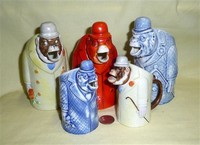 |
Dapper apes on their way to court a lady also come in a range of sizes and colors. Apes must have been quite popular because they are one of the more readily available S&V animals these days. |
S&V? The knowledgable seller swears it is...a Lion pitcher of all things. Certainly idisyncratic enough to be one of theirs, albeit a very different style that my other animal pitchers. Hey, for $25 what is there to lose?? |
|
|
|
 |
It turns out that the Mother Goose theme is sufficiently popular that the S&V version has not only been copied but supplemented by other makers. Here is a gentleman with a lid (if S&V made one I've never found it, albeit before I bought this set I did buy an unmarked one thinking it might be S&V)) and a lady that is unmistakably a close though not exact copy of the S&V one. I normally would have passed them up, but wanted to find out who made the ones that are so similar to S&V. It turns out that they aren’t even German, but rather as shown bear the mark of “The Horchow Collection”, as well as “Made in England”. Naturally I dashed to Wikipedia, finding that “Samuel Roger Horchow (born July 3, 1928 in Cincinnati, Ohio) is a catalog entrepreneur and Broadway producer…In 1971, Horchow started The Horchow Collection, the first 'luxury mail-order' catalog that was not preceded by a brick-and-mortar presence. He sold the Horchow Collection to Neiman Marcus in 1988.” Horchow has produced quite a number of successful Broadway plays, and is the author of three books. I wonder if he realizes that somewhere along the line he (or maybe Nieman Marcus?) copied S&V? |
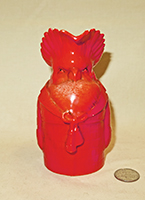
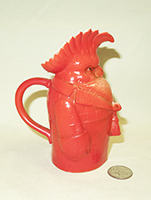
|
|
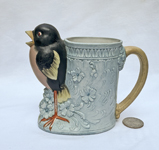
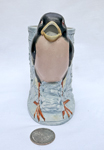
|
|
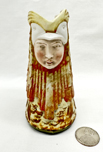
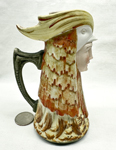
|
|
|
|
|
|
|
|
Sure enough, if one waits, a blue cat appears |
|
At last, a dog. An orange bulldog that is. This is more a vase than a pitcher, but I couldn't resist. He came all the way from Australia, and there probably aren;t too many of them - perchance because he's so ugly. I love him nonetheless, even if my wife is unimpressed. |
|
Both of these were sold as S&V by very experienced sellers, and they are indeed hard bisque porcalein. However the coloration, glaze and flat bottoms imply to me that they came from a different factory, likely in the same Ronstadt areea of Germany. The print of the "Made in Garmany" stamp on the bottom of the mountain goat, and the flat bisque base, match that of a strange looking standing pig shown in a couple places in the Modern Variation pages, so I suspect they came from whichever factory produced it. They were sufficiently inexpensive and nicely done that I don't regret taking a chance on them. |
|
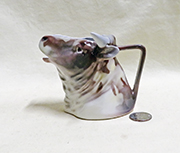

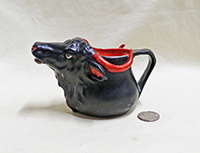
|
|
|
Fitz & Floyd. If I had to pick a third favorite, this US brand company would qualify. In great American entrepreneurial fashion you have to dig for anything about them on their web site since it’s basically a sales outlet. They’ve been in business since @1960, with studios in Dallas and production wherever they can get a good deal (China, Taiwan mostly), or so it seems to me. They make “handpainted ceramic giftware, tableware, decorative assortments, home fragrance and collectibles”, which I interpret as meaning just about anything ceramic that will sell, plus a bunch of other stuff.. Occasionally they go through spurts of popular themes, and for a while in the 90’s produced a number of quite lovely cow items. Go to the Christmas theme, for example, to see their superb “Eight Maids a’ Milking” pitcher. Here I feature just two of their cow ‘collections’ – |
|
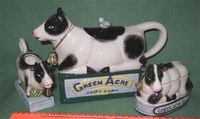 |
this Green Acre Dairy set from 1996, and… |
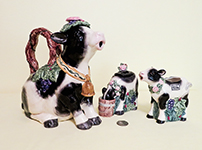 |
the lovely Heidi Holstein who dates from 1994, here with the teapot, creamer, and sugar, plus… |
|
|
|
|
|
|
|
Next are a number of other designed-in-the-US and produced overseas examples.
|
|
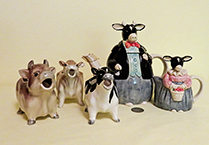 |
Otagiri Manufacturing Company, more commonly called OMC, was based out of San Francisco and its products were (originally) manufactured in Japan. Around the 1960s, a very similar company called Jard Products arose that had the same designs and even nearly identical stickers. In the mid-1990s, Otagiri was sold to Enesco Corporation. Otagiri, like Fitz and Floyd, seems to have periods when cows are a popular theme. |
|
From http://collectibles.about.com, I learned that “George Zoltan Lefton was a Hungarian immigrant who arrived in Chicago in 1939. Although his background was in marketing and designing specialty clothing, he had a passion for collecting fine porcelain. The Lefton Company was founded in 1941 … he traveled to Japan in 1945 to seal an importing agreement and the first Lefton China product marked "Made in Occupied Japan" reached the United States in 1946… The Lefton Company was purchased by OMT Enterprises in 2005 and moved to California”. Lefton made cups, pitchers, etc in this cow-shaped form, and they not only were popular themselves, but have been quite widely copied. There are a number of examples elsewhere in the collection. |
|
|
Mary's Moo Moos were created by artist and designer Mary Rhyner-Nadig. They are one of the many collectible product lines of Enesco, a producer of giftware and home and garden décor products, based in Itasca, IL. Moo Moos seem to be quite popular, and there are a number of collectors clubs. Most of them are figurines, but there are (at least) these two that fit my collection, a creamer (albeit the cow itself is not the creamer) and this teapot, ©1993. |
|
|
|
 |
Next, here are a few of my favorite modern English brands. First, a couple fancy cows from Royale Stratford. They had a reputation as one of England’s finest makers of bone china, but ceased production in November 2005. These specialty ceramic, porcelain and china companies seem to all be disappearing or being absorbed. |
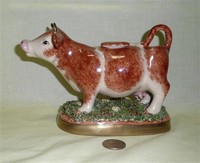
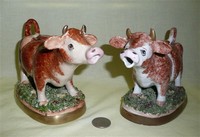

Apparently being ‘one of the finest …’ gets your stuff purchased and resold by Eximious of London . That was a new word to me, so first I looked it up and found that my huge Webster’s unabridged says that yes it is indeed obsolete, but that it means ‘select, choice, excellent’. The blue Eximious logo goes a bit further, claiming ‘Excellent, Distinguished, Elegant’. Dr Bill Long’s Spellers Diary gives a somewhat fuller explication: “When the Puritans began to publish their voluminous sermons and theological treatises in the 17th century, they bequeathed to the English language not only a peculiar Scripture-centered piety that has been rediscovered by many in our day, but they discovered (or invented) lots of words to capture the fullness and transformative power of the Gospel that they preached… one of their words, eximious, [was] used by the greats such as John Owen and John Flavel, and meaning ‘excellent, distinguished, or eminent.’ Granted, the OED says that it was a common term in 17th century literature which assumed a rather pedantic meaning in the 19th (see the discussion of esurient in a previous essay), but I was impressed through some quick internet searches of the way it is used in connection with the ‘eximious way of the Cross’or ’eximious expression of love’ by the Puritan preachers.” See what you can learn from the bottom of a cow? Incidentally, the www.eximious.com web site notes that “Josephine Louis, founder and Chairwoman, discovered the charming and elegant shop called Eximious during the time she lived in England in the 1980's. Famous for gifts and monogrammed accessories - the Belgravia shop so thoroughly inspired Mrs. Louis that she decided to start a catalogue and shop in the United States. Twenty four years later, Eximious of London has become synonymous with the understated good taste and elegance of British traditions and is justly proud of a clientele in numerous countries…Eximious' well-deserved reputation is the result of a tireless quest throughout Europe and the world by Mrs. Louis and her staff, who travel for months in pursuit of the select collection of treasures which she is so delighted to share with you.” |
|
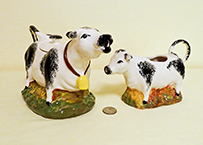 |
This teapot and creamer are marked for Moorland, Staffordshire, Chelsea Works, Burslem. This pottery studio was started by the Hungarian Joseph Szeiler in Staffordshire in 1951. His Burslem factory opened in 1955. After his death it was taken over and renamed Moorland (after the address) in the mid-1980s. |
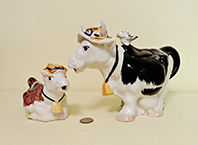 |
Here are a creamer and teapot from Price & Kensington Potteries, another of the famous Stoke on Trent factories; they’re now part of the Rayware Group. We bought them at the P&K outlet at the factory. |
 |
These three are humorous ‘take-offs’ on the cow creamer by Beswick, a famous maker of high quality figurines. From www.myantiquemall.com, I learned that “J. Beswick (pronounced BESS-wik) started his Staffordshire pottery around 1894 making dinnerware and such ornamental ceramics as the then ubiquitous Staffordshire cats and dogs. Most were unmarked and are hard to tell from their competitors’.” In 1934 descendents John Ewart and Gilbert Beswick introduced high fired bone china figurines of “unmatched quality and detail” first featuring animals in humorous settings, and then under ceramicist Arthur Gredington they started using named breed champions as models. Their champion horses, dogs, and cows were very famous and popular (and expensive). In 1969, having run out of heirs to run the firm, the family sold out to Royal Doulton. I’m sure that there is a story to accompany these ‘creamers’; they are actually ‘models’ or satires of creamers, and have no mouth holes. They were designed by Graham Tongue, and were made from 1982-89, Model #2792. The one with the yellow flowers seems to be the most common, but as seen here there are also blue and purple versions (and maybe more??). |
 |
The Emma Bridgewater line of china includes cow creamers in several of their patterns. They have recently been reintroduced, presumably in time for Christmas ’07 shopping, albeit they bear (for some reason that truly puzzles me) a warning that they are not intended for food use. Given their price (£50 from their web site, often much more on ebay!) this seems truly strange and inappropriate. Be that as it may, I of course needed one of each pattern that they make…they and a bit of Emma's story are on page 3 of Modern Variations, along with a couple collector’s versions. |
“Kent” cow creamers bearing the knot logo, like the ones on the right and center in this photo, date from 1944-1962 (when the factory stopped making them) and were produced from 19th century molds. The Museum of Pottery and Art in Stoke on Trent (home of the fabulous Keiller collection of Staffordshire cow creamers) has reproduced some in various colors (with the knot logo) for sale exclusively at their gift shop; the creamer with the green country scene on the left is one of those. William Kent initially established his factory in Burselm in 1878, and produced ‘Old Staffordshire’ style pottery from even older molds. The early Kent versions, as well as those that predate his operation or have been reproduced more recently, are unmarked. They come in a wide range of colors and decorations, both on bases and free standing. All however have lids. See Jim Hurford’s website http://www.ling.ed.ac.uk/~jim/ for some examples of older ‘Kent’ type creamers in the Staffordshire theme. |
|
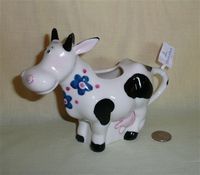 |
To conclude this page, here is one last favorite European company. This is Villeroy & Boch’s “Happy Farm” cow, the only modern one that they have made as far as I know. . Wikipedia tells us that the company that because V&B “began in the tiny Lorraine village of Audun le Tiche, where the iron master François Boch set up a pottery company with his three sons in 1748. In 1766 Boch was licensed to build a ceramics kilnworks nearby at Septfontaines, Luxembourg, where it operated a porcelain factory. In 1785 Nicolas Villeroy became sole owner of the faience manufactory at Wallerfangen. In 1812 Jean-François Boch began construction of kilns at the nearby town of Mettlach, Saarland. In 1824 Boch commenced transfer printing on porcelain from engraved copper plates. On 14 April 1836, the Jean François Boch company merged with that of the competitor, Nicolas Villeroy, and became Villeroy & Boch, (V&B, also simply 'VB'). Since 1869, when Villeroy & Boch opened the first manufactory specializing in architectural tiles, the company has operated in three main areas, autonomous until 1982, tablewares, tiles for flooring and revetments, and fine plumbing fixtures…The company's Luxembourg factory was closed down in 2010. While the company is no longer run by a family member, under the present Group Chairman Frank Goering, there are various family members currently working in the company. Since 1990 the company… has been listed on the German stock market but the voting capital is still in the hands of the family descendants.” These days V&B is worldwide but has its broadest market in Germany. For a detailed history of its founding and development over the past 250 plus years, go to www.villeroyboch-group.com/en/company/our-stories/history.html. I have a four lovely souvenir cow creamers made by V&B in Luxembourg, presumably in early 20c, that are shown on the Advertising And Souvenirs page. |

